In theory, Fair Trade is precisely the episode that Star Trek: Voyager needs right now.
From the outset, the show has struggled with several major problems. Superficially, Voyager has struggled to distinguish the Delta Quadrant from the Alpha Quadrant, to the point that the Kazon felt like low-rent Klingons and the various aliens-of-the-week seemed largely indistinguishable from the aliens-of-the-week featured on the sibling shows. More fundamentally, the show failed to conjure an air of mystery and intrigue about the region. Everything about the show felt too safe, right down to the characters. This was a show where terrorists became model officers.
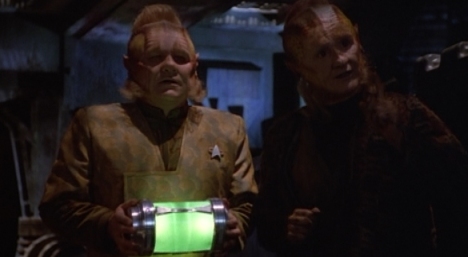
Venting plasma…
Fair Trade feels like it should offer the perfect remedy to all of this. The opening scenes find Voyager brushing up against “the Nekrit Expanse.” It is a region of space that is pointedly different and alien. Neelix has no idea what lies beyond. The sensors cannot penetrate it. Voyager is forced to dock at a local space station to take supplies, one crowded with aliens of multiple species engaged in shady dealings. More than that, the episode hinges on the neglected character of Neelix. It returns to early undeveloped suggestions the Neelix is not all he claims to be.
However, in practice, Fair Trade is disappointing. The episode lacks the courage of its convictions, both as a script of itself and as clear demarcation within the third season. It is a show rich with promise that offers up any number of intriguing ideas, but lacks the courage necessary to follow through on them.

In a bit of a Wix.
One of the big issues facing Voyager has been the sense that it is not actually going anywhere new, boldly or otherwise. Too many episodes, too many aliens, evoke iconic Star Trek moments. Despite the fact that the crew are stranded in the Delta Quadrant, they have frequent contact with aliens that look and feel familiar. A Romulan appeared in Eye of the Needle. Two Ferengi made a guest appearance in False Profits. Q turned up in Death Wish. A Cardassian missile popped up in Dreadnaught.
Even outside of the alien species literally recycled from past shows, too many episodes felt derivative. The euthanasia debate in Emanations had already been handled by Half a Life. The romantic comedy leading to a costumed run around with Q in The Q and the Grey recalled Q Pid. The “badass captain versus weird science mutants” plot in Macrocosm evoked Genesis. Even the Kazon themselves felt like reheated Klingons, a brutal warrior culture that were awkwardly racially coded.
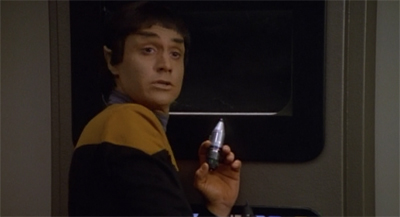
“Congratulations, Ensign. You’ll go pon’farr.”
There was very little to distinguish the Delta Quadrant from the Alpha Quadrant. The aliens looked largely the same, falling back on the classic “forehead of the week” make-up designs that could begin to feel a little repetitive after a while. Perhaps the biggest difference between Voyager and its sibling shows was the recurring sense that Voyager was travelling through a post-Cold War landscape that was not populated by rival empires but by developing nations. Voyager tended to stumble across primitive cultures, or those in desperate need of aid or support.
With all of that in mind, the Nekrit Expanse feels like a step in the right direction. It feels like Voyager is continuing the efforts to draw a line under the first two seasons that began with Future’s End, Part I and Future’s End, Part II. The big purple cloud introduced in the teaser to Fair Trade serves as a literal representation of that threshold, representing a very literal frontier for Voyager to cross. It represents the end of Neelix’s knowledge of the region, and so serves to close the book on a chapter of the show that began with Caretaker.
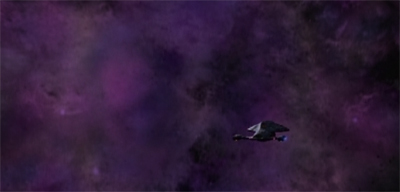
Cloudy with a chance of noir.
In the documentary Real Science, writer and science advisor André Bormanis outlines his inspiration for the Nekrit Expanse as something unique within the Star Trek mythos:
The Nekrit Expanse is something that I came up with, for my first script for Voyager. We wanted to suggest a region of space that was rather dangerous, that was difficult to navigate. It was too big to go around, we had to figure out a way to go through it. And the Expanse itself, I’d kind of modelled after some of the regions that we’ve identified, in telescopes, in our galaxy that you probably wouldn’t want to send a space probe into, at least not very far. There are regions of space that, contrary to popular belief, are not just sort of empty. Not pure vacuum. They are filled with subatomic particles – gas and dust, radiation of various forms. One example of this is a supernova remnant. When massive stars explode in these gigantic fireballs called supernovae, they will send at of material out into space. The outer layers of the star’s atmosphere will expand at incredible velocities into what is called the interstellar medium, the space between the stars. And this will actually sometimes create shockwaves and secondary effects that could be real trouble for a space craft trying to navigate through the denser portions of such a phenomenon. So that was the basic idea. You know, sort of a dark and spooky place that would be very difficult to navigate, very dangerous, and we have no idea what’s on the other side because it’s sufficiently opaque that our sensors can’t penetrate very far into it.
It is certainly an intriguing concept, and something markedly different than the obstacles that have blocked Voyager’s course to this point. It is not something as simple as enemy space like that presented in The Swarm.

His knowledge of warp core plasma is expansive.
Indeed, the production team seemed to like the idea of the Nekrit Expanse so much that they latched on to it for future story opportunities on Star Trek: Enterprise. When the fourth spin-off series ran into difficulty during its second year, and when the studio demanded a retool of the franchise, the production team returned to the idea of a region of space that was uncharted and opaque to sensors with the Delphic Expanse. Tellingly, the episode introducing the Delphic Expanse placed such emphasis on the concept that it was actually titled The Expanse.
Of course, the fact that the production team working on Enterprise felt comfortable revisiting the premise suggests that it was not executed particularly effectively on Voyager. The Nekrit Expanse as presented in Fair Trade is a great idea, but the show never follows through on the potential of this storytelling opportunity. The Nekrit Expanse is supposed to represent something new and exciting, something that exists beyond the crew’s (and the audience’s) frame of reference. However, that promise never actually materialises.

Once more unto the expanse…
What actually happens once Voyager ventures into the Nekrit Expanse at the end of Fair Trade? What surprises do the next few stories hold? Sadly, Voyager leans even more heavily upon the familiar. Alter Ego is a typical “holodeck runs amok” story. Coda features another appearance from the Vidiians. Blood Fever is a pon’farr story, and so references one of the most iconic Star Trek episodes ever produced. Unity brings the Borg back into the frame and sets up the cybernetic aliens as a recurring threat across the rest of the run of the show.
Still, it’s hard not see the Nekrit Expanse as proposed by Fair Trade as an intriguing idea and a step in the right direction. Given that Voyager is exploring space that is literally uncharted, there is something exciting about the ship and crew pushing beyond the confines of what they know. Fair Trade seems very much like a story that should have happened much earlier in the run, as a clear signalling of a desire to push beyond the safe and the familiar. It is also an episode that should have had a much bigger impact on the rest of the show.

Janeway can’t Bahrat any longer.
Even the space station depicted in Fair Trade makes for an interesting departure for Voyager. One of the few ways in which the Delta Quadrant felt tangibly different from the Alpha Quadrant was the recurring sense the it existed as a “used future”, a sense that the species inhabiting this region of space lacked the same industrial production apparatus that defined so many of the Alpha Quadrant species. There had been elements of this in the other franchise shows, most notably Star Trek: Deep Space Nine, but never to the same extent.
The Kazon are the most obvious examples, their ships stolen from the Trabe by a species not necessarily prepared for the technology. The Vidiians are an empire in a state of decline, where even their bodies are cobbled together from bits and pieces of other species. Later in the run, the Hirogen and Malon will also fit this template of alien species that lack the sort of clean production design associated with aliens like the Romulans or the Dominion or the Andorians. In a way, even the Borg would fit the template, as a species literally assembled from countless worlds.
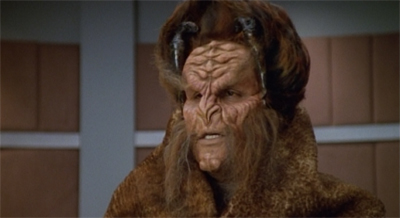
“I run a nice clean cantina… I mean trading post.”
This is a design choice that stands very much at odds with the clean minimalism that the original Star Trek established for its alien worlds, sets built in bright colours and in straight lines. This was generally the case with science-fiction. Many critics would point to Star Wars as the point of transition, with the production design eschewing that sterility for something more “lived in.” As Charles Champlin argues in The Creative Impulse:
Lucas’s emphasis on the idea of a used future, a future that was meant to be experienced as reality rather than fantasy. The Star Wars future was not showroom shiny but dented and rusty, as if it had hard use on the back roads on innumerable galaxies. Lucas told an interviewer during production in England that the Apollo capsules may have looked brand new when they soared away, but it was clear when they returned that the interior was littered with candy wrappers, empty Tang cans, and other trash, just like the family station wagon.
Toward the end of the seventies and into the eighties, cinema embraced the idea of a grotty future populated with rusty metal and dim lighting. The cleanliness of Logan’s Run gave way to the industrial horror of Alien. The sterility of 2001: A Space Odyssey made room for the dreary urban landscape of Bladerunner. It was a transition that Star Trek largely avoided. Even Deep Space Nine cleaned up rather nicely after Emissary.
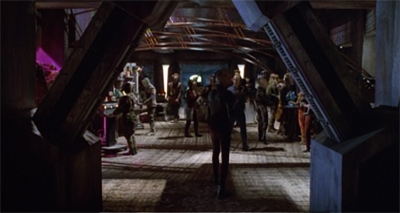
Market place of ideas.
The alien station in Fair Trade plays into this idea of the Delta Quadrant as dilapidated and decayed. The station is nominally an interstellar marketplace, in which representatives of all species come together to trade. However, it is clearly not a state-of-the-art institution and is most definitely not designed for the comfort of its visitors. The lighting is poor. There are no windows. The colour scheme is very grey. The design recalls the architecture of the Soviet Union, cold and efficient more than warm and welcoming. It looks more like a shanty town than a shopping centre.
The aliens inhabiting the trading post all seem to be shady dealers. More than that, the production design veers away from the standard Star Trek template of forehead ridges and funny noses. Fair Trade features a number of different alien species, and all of them look much more alien than the Akritirians from The Chute or the Ilari in Warlord. Indeed, the station is overseen by Bahrat, who looks rather like a cross between a bear and a rat. Bahrat looks like an alien who belongs in the cantina scenes from the Star Wars franchise, especially with his furry coat.
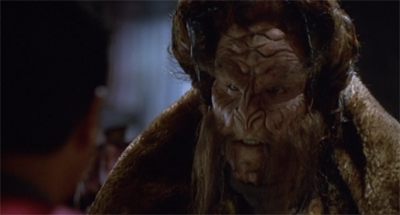
“Yes, this is a stylish coat. I’m glad you noticed.”
In fact, it feels like Star Wars had a fairly considerable impact on the portrayal of the trading outpost and its inhabitants in Fair Trade. The station is certainly presented as a “wretched hive of scum and villainy”, with Chakotay and Paris hassled by a drug dealer within minutes of setting foot on the trading floor. The casualness with which Fair Trade embraces ideas like drug trafficking underscores just how creepy this environment actually is. When Symbiosis wanted to tackle drug addiction, it made it the centrepoint of an episode. Fair Trade treats it as a fact of life.
The obvious comparisons between the space station in Fair Trade and the locales featured in Star Wars make a certain amount of sense. After all, Fair Trade was broadcast less than a month before the much-hyped theatrical re-release of Star Wars in late January 1997. Of course, Star Trek and Star Wars had always had an interesting and complicated relationship with one another. Deep Space Nine was in many ways embracing the pulpy themes of space conflict and mysticism more firmly associated with Star Wars. It makes sense Voyager would take its own inspiration.

Love is the drug.
Also, drugs are the drug.
The space station is a very effective piece of production design, one that demonstrates the level of skill and care taken by the staff working on the design aspects of Voyager. Quoted in Science Fiction Television Series, 1990-2004, director Jesús Salvador Treviño outlined the work involved in bringing the environment to life:
That was my initiation into the Star Trek family and unlike most episodes, where one or two alien races are featured, here we created an interstellar marketplace where many races came to trade. We created more than a dozen different alien races for the scenes in the marketplace and that proved to be a challenge. I wanted to give the sense that the marketplace was big but since it was on Paramount’s Stage 16, it was rather limited. I had the idea of creating a greenscreen arcade at one end of the marketplace. I first plugged this window and shot a marketplace plate shot full of aliens. Then I took the plug out of the greenscreen area, thus doubling the size and depth of the marketplace. I did this again (tripling the apparent depth of the market place) and had Paris and Chakotay enter into the scene and look down the centre of the scene to emphasise the size of the marketplace. It was great fun to use these technical tricks to help sell the sense of wonder.
The marketplace featured in Fair Trade is an exciting and compelling setting, populated by memorable species. Michael Westmore does excellent work on supporting characters like Sutok or Tosin, the skill evident in their design all the more effective for the fact that they only appear briefly in a single episode. This recalls the fascinating texture of the background players in the Star Wars universe, bit players who look interesting enough to inspire the imagination.

Business as unusual.
Once again, the influence of Fair Trade would be felt on the development of Enterprise. The portrayal of the trading outpost in Fair Trade, with its diverse aliens and questionable moral character, feels very much like a spiritual predecessor to the depiction of Rigel X on Enterprise. That particular trading post would become one of the few locations that the crew would visit on multiple separate occasions over the course of the four-season run, bookending the series with appearances in Broken Bow and These Are the Voyages…, with an appearance in The Seventh.
However, the scruffiness of the trading outpost in Fair Trade exists very much in opposition to the tidiness and cleanliness of Voyager. To be fair, this is not a problem with the individual episode so much as with the show around it. The scrappy used aesthetic of the Delta Quadrant stands in sharp contrast to the immaculate appearance of Voyager itself. Despite being stranded half way across the galaxy without any support, Voyager never loses that “new starship” smell. No matter how many beatings the vessel may take, the ship always returns to pristine condition.
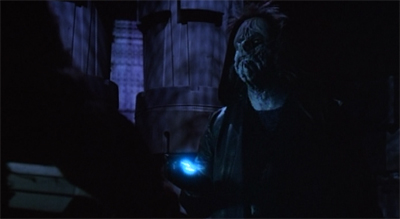
Ah, the Delta Quadrant. Where you can’t even trust your local drug dealer.
This is one of the show’s original sins, and it has become quite clear that the production team are not interested in taking the steps necessary to remedy it. As such, Voyager itself seems almost out of place when it arrives at the trading post claiming to be in dire need of supplies. When Janeway visits Bahrat, she insists that Voyager needs peregium “to regenerate the filters on our environmental control system.” That certainly sounds important. However, the show has never convincing generated a sense of peril or threat.
In many ways, this is incidental to the plot at hand. Voyager needs the peregium because the episode needs there to be a reason for the ship to stop at the trading episode and it would also be nice for Neelix and Wixiban to be able to source something important for the crew. However, this has never been mentioned before and will never be mentioned again. It never feels as though Voyager might actually be in trouble if it can’t acquire any peregium from the trading outpost. As such, Voyager stands out against the scruffy rag-tag nature of the traders.
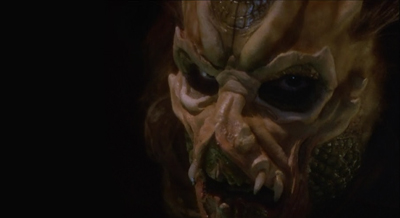
Face off.
Fair Trade is a story about Neelix, which is interesting of itself. Voyager has a habit of completely abandoning about half its cast, slotting characters like Chakotay, Tuvok and Kim into generic narratives once or twice a year. This transition was already taking place in the third season, and would be cemented with the arrival of Seven of Nine into the cast in Scorpion, Part II. From the fourth season onwards, the series was clearly dominated by the trio of Janeway, Seven and the EMH.
However, Neelix was never quite abandoned. Like Torres and Paris, Neelix fell into the middle-ground of the ensemble. The character could generally be counted upon to be given something to do, even if he never dominated the series to the same extent as Janeway, Seven or the EMH. Neelix could anchor stories as diverse as Jetrel, Mortal Coil, Once Upon a Time or The Haunting of Deck Twelve. It was too much to suggest that Neelix was a well-rounded and fully-fleshed-out character, but he certainly held the production team’s interest more than Chakotay or Tuvok.

Warp core values.
At the same time, there is a clear sense that Voyager struggled with Neelix. The character did not really work in a practical sense. This is strange, given that Neelix has perhaps the strongest sense of purpose of any character introduced in Caretaker. Once Voyager finds itself stranded in the Delta Quadrant, Neelix is the local alien who is drafted on to the crew so that he might serve as a guide. More than that, Neelix is introduced firmly outside the established Starfleet hierarchy. While Chakotay, Paris and Torres all at least attended Starfleet Academy, Neelix is something else.
As established in Caretaker, Neelix is a rogue. Operating out of a broken-down old ship, Neelix is introduced as a character who is not entirely trustworthy. He brings Janeway to meet the Kazon, neglecting to mention that he is not on the best of terms with the Ogla; it is implied that Neelix stole water from the Ogla. He also involves the Starfleet away team in a plan to rescue Kes, declining to inform Janeway that she is being made party to a haphazard plot to spring his girlfriend from the clutches of the Kazon.
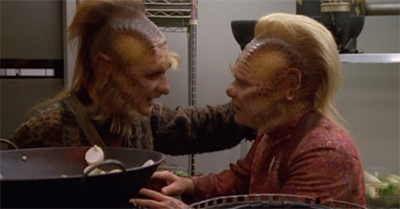
“Please! As far as they know, I’m just the plucky comic relief!”
Ethan Phillips acknowledged as much, reflecting on how the concept of Neelix changed dramatically from his introduction:
“Neelix began life on Voyager as sort of a roustabout,” notes Phillips. “I wouldn’t necessarily say that he was a nefarious guy, but he certainly was involved in his share of shady dealings, as we found out when he met up with his old pal Wixiban [James Nardini] in the episode Fair Trade. However, in the show’s seven years he changed and became somebody who wanted to take more pride in his accomplishments.”
However, this aspect of Neelix was never actually addressed on-screen at any point in the first season. He was just presented as a lovable toyetic alien.
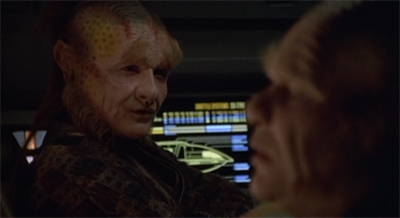
“So… you still dating that two-year-old?”
Even Neelix’s relationship with Kes is something of a red flag. Even on a conceptual level, there is something disconcerting of a sexual relationship between a fully-grown man and a two-year-old girl, regardless of how vocally Voyager might protest that Kes is mentally and physically around the age of twenty. For what it’s worth, Neelix seems decidedly older than that and it is left ambiguous to precisely how long the pair have known one another when Janeway rescues Kes from the Ogla.
More than that, the particulars of the relationship are far from healthy. Neelix is consistently and repeatedly portrayed as abusive towards Kes, something that seems especially creepy given her own lack of life experience beyond being captured and chained by the Ogla. In Phage, Neelix emotionally manipulates Kes to ensure that she would not consider leaving him following the removal of his lungs. In Twisted, Neelix brutally lays into Kes for the simple fact of knowing where some of her (male) colleagues live. This is to say nothing of Parturition.

“We come bearing gifts. In exchange for other gifts. So… more trade goods.”
These elements do not make Neelix a poor character, per se. Indeed, they quite consciously mirror the characterisation and definition of Quark on Deep Space Nine. In many ways, Neelix seems like something of analogue for Quark. They are both rogues who exist outside the two competing organisational hierarchies in their respective shows, they both operate out of dining establishments, they are both latex-heavy aliens. In fact, both Shimerman and Philips had established themselves within the franchise by playing Ferengi on Star Trek: The Next Generation.
Like Neelix, Quark was a troublesome character over the first few seasons of Deep Space Nine. In those early episodes, it frequently seemed like Quark only existed to bring terrible or dangerous objects on to the station to threaten the rest of the cast; he is responsible for the dangerous game in Move Along Home, the energy vibrations in Q-Less, and the terrorist attack in Invasive Procedures. However, the writers made a point to develop Quark as a character to the point that he retained that unique premise and grew so that he could support episodes like House of Quark or Body Parts.

“You know, when I ordered twin bodyguards, I thought they’d be creepier and more intimidating.”
In contrast, Neelix suffered from the big recurring problem with Voyager as a whole, a strong resistance to anything resembling conflict or ambiguity. Neelix was an interesting character, but a lot of what was interesting about him lay in how he didn’t fit in with this crew. As with the incorporation of the Maquis into the crew, there was a lot of potential for interesting contrasts and debate. Unfortunately, also as with the incorporation of the Maquis into the crew, any possibility of conflict was quick abandoned in favour of the appearance of harmony.
As such, Voyager took the edges off Neelix. The show never acknowledged his roguish tendencies. His attitude towards Kes was treated as overly-protective rather than simply abusive. In fact, the show famously ended the relationship between Neelix and Kes in the episode Warlord, in which an evil alien despot took over the Ocampan’s body for the twin purposes of chewing scenery and breaking hearts. This is Voyager, where even toxic and poisonous relationships evaporate without a hint of conflict and without acknowledging the unpleasantness.

Neelix needs to vent.
In an interview with Star Trek: Monthly, Ethan Phillips alluded to a scene that was shot for Fair Trade, but cut from the broadcast episode, that would have dealt with this idea:
Neelix never said goodbye to Kes. So now we’ve got that closure that I missed. We’d actually filmed a scene for the episode Fair Trade, way back in the third season, where I did say goodbye to her, but the scene was never aired, for whatever reason. I think it was because the show was running long and the scene wasn’t integral to the plot.
Indeed, this particular cut reveals a lot about how the production team approached writing and editing on the series. Voyager was always a plot-driven show, seldom making room for the little character beats that made Deep Space Nine so effective.

“You two look just like my target market…”
With all of this in mind, Fair Trade feels very much like a long-overdue Neelix episode. It is an episode built around several ideas about Neelix as a character that have been bubbling away in the background since Caretaker, but which have never been properly elucidated. The first of these ideas is that Neelix has misrepresented himself to Janeway, that he does not know as much as he claims about the Delta Quadrant and that he is invested in the comforts that Voyager affords him.
After all, working on Voyager is like living in a holiday resort compared to life in the rest of the Delta Quadrant. It is certainly questionable how much Neelix materially provides to the crew. What use is a morale officer when the holodeck exists? What is the point of a cook when the replicators function? Neelix makes much of his skills as a guide, but he still manages to get attacked by the Vidiians in Phage and even aligns the ship with a bunch of former slavers in Alliances. Kes at least works in sickbay. Neelix seems somewhat less essential.

“This certainly looks like a reputable establishment.”
In Fair Trade, the crew brush up against the limits of Neelix’s knowledge. It turns out that Neelix only has encyclopedic knowledge of three-years’-worth of Delta Quadrant travel, which is quite remarkable given that Voyager is portrayed as a much fast ship than his own beat-up little ship. Then again, given that the crew encounter a colony of Talaxians half-way back to the Alpha Quadrant in Homestead, perhaps it is surprising that Neelix’s knowledge doesn’t extend even further. Still, Neelix refuses to own up to the fact that he has no idea what lies ahead, afraid of losing his status.
This is something that runs quite counter to Gene Roddenberry’s romantic notion of idealised characters who serve as paragons of virtue. After all, Neelix runs the risk of putting the crew in danger if he refuses to tell Janeway that he has no knowledge of the galaxy beyond the Nekrit Expanse. A more straight-laced character would acknowledge this, and realise that it isn’t such a big deal in the grand scheme of things. Instead, Neelix is so worried about Janeway’s perception of him that he makes a series of bad decisions that lead to murder and carnage.

“Well, with a face like this, I couldn’t really go into hospitality.”
It is a rather interesting take on Neelix as a character, on that plays into the episode’s second big idea about who Neelix is as a character. Fair Trade draws attention to Neelix’s shady past, not the breakfast-show-hosting mess-hall-running morale officer that Janeway knows and loves, but the wheeler-dealer who thought it might be a good idea to steal water from the Kazon. At the trading post, Neelix stumbles upon an old associate. Wixiban is a fellow Talaxian and former business partner. He also spent several years in prison for crimes that he and Neelix committed together.
This is an interesting set-up, particularly as Neelix tries to conceal his past from Janeway. The most interesting moments in the episode come during the scenes where Wixiban is interacting with the Starfleet crew, and Neelix is tangibly worried that his old friend will let something slip about the man that Neelix used to be. It is a delightful tension, if only because it is willing to make Neelix a more complicated character. Given how Wix has suffered for Neelix’s sins, it is hard to feel too worried about Neelix’s embarrassment. However, Neelix’s reaction is understandable in its own right.
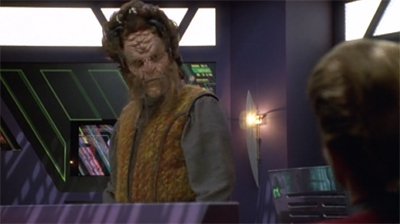
Manning his station.
This is an interesting approach to characterisation for Voyager, a show that typically frames its leads in unambiguous terms. It is difficult to imagine a character like Worf or Odo or Kira or Quark existing on Voyager. The series insists that Janeway exist as the paragon of virtue or the embodiment of wrath from one episode to the next, but seldom anything in between. Fair Trade is perfectly willing to let Neelix behave in a manner that is both unpleasant and reckless, yet entire sympathetic. Voyager should adopt this approach to characterisation more often.
Fair Trade borrows heavily from the conventions of film noir. The shady and dimly-lit location that serves as a point of intersection and last chance saloon for the lost and the desperate. The old friend from the past who harbours a dark secret. The chain of bad decisions that compound, driven by desperation and culminating in murder. The seemingly good man who turns out to be anything but. A world where law enforcement are ineffective at best and indifferent at worst. Fair Trade might not have a femme fatale, but it does hit a lot of the checkboxes.

The space bet-Wix them.
(Arguably Wix himself comes closest to fulfilling the role of femme fatale, in that he arrives into Neelix’s life out of nowhere and causes nothing but trouble. The episode even has some fun with this idea. “Where were you at the time of the shooting?” Tuvok asks Wixiban at one point. Wix doesn’t miss a beat, “In bed, asleep.” Tuvok presses the point. “Can anyone corroborate that?” Wix cheekily responds, “Alas, Mister Tuvok, I sleep alone.” It is some decidedly pulpy dialogue for Voyager. Wix might as well be puffing on a cigarette.)
While Fair Trade cannot measure up to the pulpy noir aesthetic (and production design) of Necessary Evil, it is certainly a more convincing effort than Ex Post Facto. There is something quite appealing in the ambiguity and shadiness that runs through Fair Trade, a grottiness that stands in sharp contrast to the sterile aesthetic associated with Voyager. In many ways, Fair Trade is a show about the balance between compromise and integrity. Given the basic premise of Voyager, it seems strange that so few episodes tackle those ideas.

“Nothing unusual or irreputable about what’s going on here.”
In Captain’s Logs Supplemental, Ron Wilkerson cites a classic gangster movie as the inspiration for his original pitch:
The story was essentially like Carlito’s Way in the sense that this guy comes on the ship and Neelix pretends he doesn’t know him, but in fact they were in jail together and he helped Neelix escape and they split up afterward, and now he’s looking to get Neelix to do something for him or he’ll reveal his past to everyone.
There is more ambiguity in the finished episode. It is to the credit of Fair Trade that Wix never seems like an antagonist or villain. He’s just desperate.
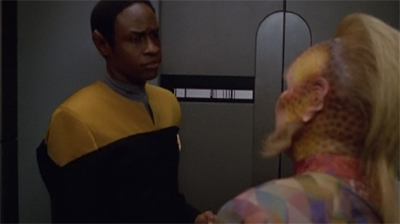
“You’d think being an accomplice to drug dealing and murder would convince Captain Janeway to keep you off my security team, but apparently not.”
However, Fair Trade never quite commits to that interesting tension between Wix’s justifiable anger at a former partner who happily left him rotting in prison and Neelix’s desire to reinvent himself as something better. Fair Trade falls back into the familiar Voyager patterns, consciously playing down any hint of conflict between its characters to insist that there is no disagreement that cannot be resolved through something as simple as friendship. It is an endearing idea, but one very much at odds with all those film noir tropes littering the narrative.
This reluctance to commit to character conflict is most apparent in how Neelix and Wixiban choose to respond to the murder of Sutok. Initially, it seems like Neelix wants to come clean while Wix wants to hide the truth. These are logical positions, given what we know of these two characters. Inevitably, the conflict comes to a head when Bahrat arrests Chakotay and Paris for the crime. Wix had been trying to resolve the issue quietly, but Neelix refuses to let his two friends go to prison for a crime that he committed.
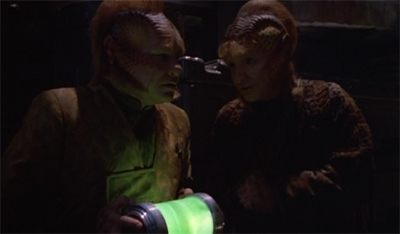
“I… have a cunning plan.”
Now, there are a number of interesting directions that the story could take from that point. Wix could point out that Neelix was perfectly happy at one stage to abandon his old friend to prison rather than face the consequences of his actions. Wix could insist that Chakotay and Paris will be exonerated. Wix could threaten to expose Neelix to Janeway and Bahrat as payback. After all, Wix really doesn’t want to go back to prison. Although “cryostatic suspension” may not be exactly like an Ubean prison, it still sounds very unpleasant.
“Your plan is crazy,” Wix insists when Neelix formulates his plan. “It’s worse than prison, it’s a death sentence.” Neelix responds, “That would be better than living a lie. I’m going whether you do or not.” Neelix marches towards Bahrat’s office. Wixiban hesitates, and then makes a move to stop him. How far is Wix willing to go to save his own neck? Not that far, it turns out. “Neelix!” he shouts. “We’ve been through too much together. I can’t let you do this alone.” It’s a touching moment, but one that never feels earned.

“Oh, there is going to be some serious venting about the quality of this warp plasma on Yelp.”
Indeed, it could be argued that Wixiban is the far more heroic of the two characters here. Neelix has spent more than two years on a state-of-the-art ship after skipping out on his best friend. If anything, this reckoning is long overdue, and Neelix has no idea what it actually means to pay for the consequences of his actions. Wix decides to join Neelix, despite the fact that he has actually served time in prison. Wix has a better understanding of what is at stake, which almost makes his decision to go along more heroic than Neelix’s decision to turn himself in.
(All of this makes Wix’s strange disappearance at the end of the episode rather surreal. When Neelix wakes up, Tuvok informs the disgraced morale officer that Wix “sent [Neelix] his thanks before making a hasty departure.” This seems rather strange. If the production team weren’t interested in reconciling the two characters at the end of the episode, it might have made more sense (narratively and thematically) to have Neelix face Tosin alone. After all, that would have neatly reversed Neelix’s original sin of leaving Wix to face the music.)

Morale’s that ends well.
Fair Trade also avoids any hint of conflict in the closing scene once Neelix confesses to Janeway. Janeway is justifiably angry at Neelix for lying to her, for getting the ship embroiled in a murder investigation, for getting Paris and Chakotay arrested and for almost getting himself killed. However, Janeway’s justifiable anger is tempered by the insistence that everybody on Voyager get along. As such, it never feels like Neelix is held fully accountable for the decision that he made.
It is a sequence that underscores how ineffective Voyager renders Janeway during these scenes. Picard and Sisko get much more convincing sequences laying into subordinates, if only because the scripts seldom feel the need for them to hold back. There is no doubt about how disappointed Picard is with Worf in The Enemy or Wesley in The First Duty. Sisko similarly voices his righteous anger at Worf in both Sons of Mogh. In contrast, Janeway comes across as rather toothless in how she deals with behaviour that is not just disappointing but outright mutinous.
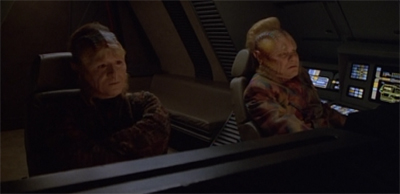
“So… how was prison?”
When Neelix complains that he is of no use to Janeway because he doesn’t know what lies ahead of the ship, Janeway even comforts him. “Well, that’s not the point, is it?” she responds. “None of us knows what’s coming. That’s what Starfleet is all about. We are all in this together, Neelix, and we have to be able to count on each other no matter how hard it gets. Do you understand?” It is a very sweet moment, and might even have been touching if Neelix had confessed earlier in the episode. However, Janeway is coddling an accomplice to murder.
Of course, Janeway punishes Neelix, at least in theory. “Report to deuterium maintenance at oh-four-hundred tomorrow morning,” she orders. “You’re going to spend the next two weeks scrubbing the exhaust manifolds. That should give you time to think about what I’ve said.” That sounds like an inconvenience rather than a particularly harsh punishment, but it does not matter. The next time that the audience sees Neelix in Alter Ego or Blood Fever, there is no hint of any shame or tension. There are no material consequences for his actions.

“I mean, c’mon. It’s not like Janeway will actually punish you.”
This is not an exceptional case. Voyager has a long history of putting Janeway in an impossible position when it comes to disciplining her crew. In Prime Factors, she declines to punish the mutineers for conspiring behind her back to violate the Prime Directive. In Manoeuvres, she explains that she cannot punish Chakotay for hijacking a shuttlecraft and violating orders. No wonder Janeway pursues Ransom so aggressively in Equinox, Part II. Finally there is a Starfleet officer that she can punish.
Even leaving aside the ways in which Fair Trade fails to live up to its potential by falling back on familiar Voyager storytelling, the episode is a great example of how weak the writing on Voyager is on a simple technical level. There are points at which, even leaving aside the content of the scripts, it feels like the writing staff on Voyager have forgotten how to structure a forty-five minute episode of television. The result is a collection of story beats that feel out of place, almost “off rhythm.”

Shooting off.
Fair Trade is notable as the first teleplay credited to veteran Star Trek science advisor André Bormanis. Bormanis would go on to serve as a member of the writing staff on Enterprise. For Bormanis, this was very much a logical development:
As science consultant, I had to read every draft of every script of every episode of TNG, DS9 and Voyager that we produced. That in and of itself was a very good education, seeing the stories and scripts unfold step by step, learning the rhythms of the shows, the voices of the characters and so on. I had the opportunity to start pitching story ideas about a year after I started, and eventually they bought a couple for Voyager. They (later) asked me if I was interested in writing a script for season three of Voyager, and of course I said yes (the script was Fair Trade). They thought I did a good job with it, and had me do a few more. So by the time I was brought on staff as a full-time writer for Enterprise, I felt well prepared.
Bormanis never quite managed to get the rhythm sown. Even when working on Enterprise, some of his episodes have that strange dissonance to them; most notably the weird pairing of a science-fiction horror story about monstrous aliens with a comedy story about Reed’s birthday in Silent Enemy.
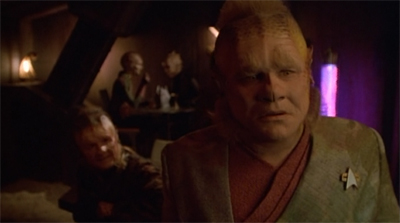
No big deal.
There are similar structural and rhythmic issues with Fair Trade. Most notably, this is the second Voyager script in as many episodes that has absolutely no idea about how to structure a teaser. Warlord for some reason decided that the crew’s new holodeck programme made for viewing so riveting that it could segue directly into the opening credits without anything actually happening. The teaser to that episode faded out on Neelix’s feet, panning down from a shot of the character dancing with three holographic ladies. It certainly didn’t scream “watch Voyager!”
Fair Trade has a similar issue. The teaser does a half-decent job setting up the theme of the episode, establishing Neelix’s sense of insecurity as the ship approaches the limits of his knowledge. He is introduced hassling Tuvok and then decides to bother Torres. Finally, he is summoned to the bridge. An ominous purple cloud appears on screen. “Neelix, we seem to be approaching some kind of interstellar dust clouds,” she states. “Can you tell us anything about them? They look rather ominous to me.”
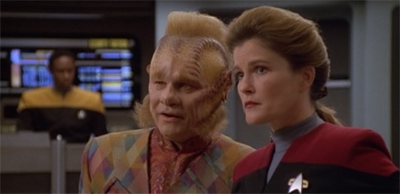
“So is this really where we’re ending the teaser?”
“Looks like it.”
Neelix responds, “I believe this is a region of space known as the Nekrit Expanse.” The music rises. The scene fades out. The opening credits sound. However, nobody has explained what exactly the “Nekrit Expanse” is at this stage. Those words mean nothing to the audience. More than that, there is no confirmation yet that Neelix has no idea what he is talking about. Indeed, viewers might reasonably wonder what Janeway finds so “ominous” about those “interstellar dust clouds.” All the audience has to go on is the music cue.
Much like it would have made more sense to close the teaser to Warlord on the encounter with Tieran’s damaged ship or even on his death, it would have made more sense to extend the teaser of Fair Trade for about thirty more seconds. The opening minute of the first act does a much better job of establishing the mystery and intrigue than Janeway’s one line of dialogue about the region in the teaser. In fact, Janeway’s “then we’ll have to go through it” would be much more effective closing line for the teaser, establishing stakes and setting the characters in motion.

You have to play the handa you’re delta.
There are other strange writing choices as well. Most notably, Fair Trade seems to muddle Tom Paris’ back story. “Do you, would you, tell me how you got in trouble?” Neelix asks Tom Paris at one point. Paris offers a summary of the events of The First Duty, advising Neelix, “I’ve thought a lot about that, and it comes down to one simple fact. I didn’t tell the truth. I made a mistake, which happens to people, but if I’d admitted that mistake it would have been a lot better. But I lied about it, and it nearly ruined my life.”
Now, this is very much in keeping with the themes of the episode. It is something that Neelix desperately needs to hear at this point in the story. In fact, the episode to which Paris alludes even gets a title drop in the closing scene between Janeway and Neelix. “You’ve been on this ship for two years,” Janeway states. “I’d think by now you’d have learned that the first duty of any Starfleet officer is the truth.” This is not a bad touch. After all, The First Duty is a great episode. There is just one small problem. Tom Paris was not in The First Duty.

Trading place.
Robert Duncan McNeill appeared in The First Duty, playing the role of Nicholas Locarno. Locarno was very much the inspiration for Paris, although the production team eventually backed away from that idea because it was felt that Locarno was beyond redemption. (Even conceptually, Voyager lacked the courage of its convictions.) Although Caretaker introduced Tom Paris as a prisoner in need of redemption, he was a prisoner who was serving time for his membership of the Maquis.
There is a considerable difference between “I didn’t tell the truth” and “I joined a terrorist organisation.” The former is Nick Locarno’s original sin, while the latter landed Tom Paris in prison. To be fair, Paris could easily be alluding to the event that led to him enlisting in the Maquis which in turn led to him ending up in prison, but it feels like a rather convoluted chain of logic. In fact, Neelix explicitly asks about Tom’s time in prison. (“I’ve heard you were in some trouble in the past. Spent time in prison.”)

Stationary orbit.
It is a strange piece of writing, and it is remarkable that nobody on staff seemed to catch the confusion between the character who inspired Tom Paris and the character of Tom Paris himself. Much like the weird structuring of the teaser, it serves as a reminder of how casual the writers were on Voyager about things like character continuity and script structure. Voyager was an incredibly frustrating piece of television, and a large part of that was down to how frustratingly lazy it could be at times. Even as it flirts with great ideas, Fair Trade is a reminder of that.
Fair Trade is an interesting episode. In theory, it is exactly what Voyager needs at this point in time. In practice, it feels like more of the same.
You might be interested in our other reviews from the third season of Star Trek: Voyager:
- Basics, Part II
- Flashback
- The Chute
- The Swarm
- False Profits
- Remember
- Sacred Ground
- Future’s End, Part I
- Future’s End, Part II
- Warlord
- The Q and the Grey
- Macrocosm
- Fair Trade
- Alter Ego
- Coda
- Blood Fever
- Unity
- Darkling
- Rise
- Favourite Son
- Before and After
- Real Life
- Distant Origin
- Displaced
- Worst Case Scenario
- Scorpion, Part I
Filed under: Voyager | Tagged: consequences, fair trade, Film noir, neelix, star trek, star trek: voyager, star wars, used future, voyager |




















“Like Neelix, Quark was a troublesome character over the first few seasons of Deep Space Nine.” The problem with Neelix as a character is that he never seems to have a purpose. I mean Quark may have been a bother in the early seasons of DS9, but he also has that great scene in “the Maquis part II” in which he gets the Vulcan to see the lack of logic in her position. With Quark, the viewer always got a sense of cunning about him even though he was not as cunning as he possibly thought he was. In contrast what does Neelix do? He dates a two year old, nearly gets the crew killed by Kazon in the pilot, nearly destroys the ship with cheese, introduces Voyager to slavers as possible allies, has a childish fight with Tom Paris, and nearly blows a covert operation by Janeway and Tuvok to flush out a spy. Neelix was so incredibly irritating that in the scene in “Meld” where Tuvok kills the holographic Neelix, I didn’t realize it wasn’t the real Neelix until he died.
Oh, that would have made Meld something truly spectacular, if Neelix had died then and there.
I still think that there’s a lot to be said of Neelix’s potential as a Quark-like character, and the show’s reluctance to explore that potential is indicative of its central flaws. Which seems to be a recurring theme of the Voyager reviews. “Here’s the flaw this week, and here’s how it all ties back to the decisions made in Parallax and Time and Again.”
The big difference between ‘Star Wars’ and ‘Star Trek’ for me was that ‘Star Wars’ ran with the idea of a galactic society where thousands of species live together in one larger society. Sure you have species homeworlds (ie. Jawas are native to Tatooine), planetary cultures (ie. Corellian) and some are less intergrated (ie. the primitive, newly discovered Ewoks) but your next door neighbour, your girlfriend or your boss might be one of a hundred different species. I know the Prequels are much maligned but Coruscant looks wonderfully diverse, like intergalactic New York or London.
In contrast ‘Star Trek’ always felt like there was suprisingly little contact between the different species. Even the Federation which should be diverse often felt like an organisation built for humans akwardly trying to fit in the odd alien.
Yep, that’s a very valid point. And it’s something that I love whenever it comes up as a criticism of the Federation. I think the “homo sapiens only club” line in The Undiscovered Country bumped that movie several places up my “favourite Star Trek films” list.
“Perhaps the biggest difference between Voyager and its sibling shows was the recurring sense that Voyager was travelling through a post-Cold War landscape that was not populated by rival empires but by developing nations. Voyager tended to stumble across primitive cultures, or those in desperate need of aid or support.”
You make an interesting point about the differences about the Alpha Quadrant and the Delta Quadrant that I hadn’t really considered. When I look back at TNG, I never really saw the crew as explorers, despite Picard’s desperate assertions in Peak Performance. The Federation and Enterprise was always involved with border conflicts with the Romulans and Cardassians, the Klingon Empire were the neighbors, and the Ferengi were stealing stuff along the Federation Border, that it gave the impression the Federation was boxed in. For the majority of the TNG era, there felt this feeling of claustrophobia, that there wasn’t enough space for everyone, causing the majority of conflicts. Sometimes I wonder how the TNG even got to explore the unknown, it felt like was there a narrow corridor somewhere on the Federation border that lead to unclaimed space so that could travel to the unknown region. When I think about TNG as a whole, the most memorable episodes happened within the Federation itself. Even in the movies, I think the only time they weren’t in Federation space, it was to visit Romulus. In fact, the Enterprise spent much of its time acting like a glorified taxi, shuttling a diplomat or Admiral around Federation territory or hosting some sort of conference on the ship. Exploration seemed like a niche hobby for the ship.
Contrast that with Delta Quadrant, which seems to lack major powers controlling it. When I think of the big villains that fought Voyager, it was the Borg, the Krenim Imperium, the Hirogen, the Viidians and the Kazon. Of those five, only one of those could be considered a major power, the Borg. When it comes to world buildings, I thought it was interesting that the writers put the Borg in the Delta Quadrant, and surrounded their territory with minor powers that had no shadow of a hope of curbing the Borg’s assimilation and expansion. It always felt like the Borg would have been an ever-growing menace. The next greatest villain/major power was a large empire, the Krenim Imperium which managed to kick around Voyager due to mucking around with time travel. But the big villain from the Year of Hell, Annorax, was from a timeline when the Krenim Imperium was previously conquered and a joke of a power. Viidians were probably a major power at one point, but the phage rotted out their Fallen Empire and I doubt the cure could undo the damage to them. And the Kazon and Hirogen were nomadic powers, perhaps powerful as a whole, but they didn’t work together and probably controlled no official territory, only squatting on planets when they needed to. In a way, this better sold the Voyager crew as explorers, since most of the space they flew through were either independent or unclaimed. There were people to meet, planets to explore, anomalies to poke at, and no Federation disputes to halt their mission. The Delta Quadrant never felt as claustrophobic as the Alpha Quadrant.
As for the Gamma Quadrant, I never felt like we got a feel for what that part of the Galaxy was like. A lot of inhabitants there never knew what a Founder was, even though it appeared the Dominion controlled what I assume was most of the Gamma Quadrant with an iron fist. It’s possible that the Dominion was only the size of the Federation, but once they seized the wormhole, it seemed like the Dominion WAS the Gamma Quadrant, even the founder homeworld seemed like a few hours’ drive from the wormhole in the The Die is Cast, along with their asteroid prison facility.
Yeah, the Gamma Quadrant doesn’t really have a character. In the first two seasons, there are hints that it is like the Delta Quadrant, lawless and populated by minor powers. But once the Dominion comes along, that is pretty much all that the Gamma Quadrant will ever be. At the same time, that makes a great deal of sense. If Voyager was going to be the “exploring” show, it made sense to let it take on the “post-Cold War Star Trek” vibe, and for Deep Space Nine to concentrate on the already-established Alpha Quadrant.
Star Trek: Voyager has not exactly been good to Neelix up until now, with the odd exception of Jetrel, but Fair Trade works well as a nice analysis of his character even though it falls a little too much in the shadow of Jetrel, and it’s founded on a misconception on Neelix’s part.
The day Neelix has been dreading for two years has finally arrived – Voyager is about to move beyond the areas of space he’s familiar with. It’s perhaps the first episode where Voyager is about to take a true leap into the unknown and to prove he’s still useful, Neelix allows an old friend to drag him into all sorts of problems.
Fair Trade is a bit too dependent on Neelix’s stupidity in order to set the whole plot in motion, but I quite liked it for the way it explores Neelix’s insecurities which are gradually revealed through his friendship with Wixiban. Although Neelix puts on a cheerful front, he’s not quite as confident as he makes out (all of his job descriptions on Voyager are self-appointed) and it’s telling that he reveals the reality of his predicament to Wixiban.
I think Wixiban is the man Neelix could have been had he never encountered the Voyager crew. The Neelix we met in Caretaker would probably have had no qualms about letting Tom and Chakotay take the fall for his and Wixiban’s crimes and perhaps in time, he might have wound up in a place like the station at the edge of the Nekrit Expanse, or worse, languishing in prison, just like poor Wixiban.
I wonder if Ethan Phillips was thinking he would be replaced with the upcoming inclusion of Jeri Ryan to the cast (Neelix was never that popular a character) before they settled on Jennifer Lien. And that adds much to the episode as Neelix’s desperation digs him into a deeper and deeper hole while trying to prove his worth to the Voyager crew. It’s a shame that the episode’s resolution hinges on the cast telling instead of showing (just like Warlord and Macrocosm) us what happened but Fair Trade works at showing us more of what makes Neelix tick.
You likened Bharat to a rate (rat?) Darren, it was The Haunting of Deck Twelve, Neelix endangered the ship in Learning Curve much as Quark used to do in the early days of DS9, Neelix danced with three holographic girls in Warlord and it was Tieran’s damaged ship, not shop.
Thanks! Those are corrected now.
Yeah, I like the idea of Fair Trade a lot more than I like the execution of it, if that made sense. I’d certainly have much preferred “more episodes like Fair Trade” to “more episodes like Alter Ego”, for example.